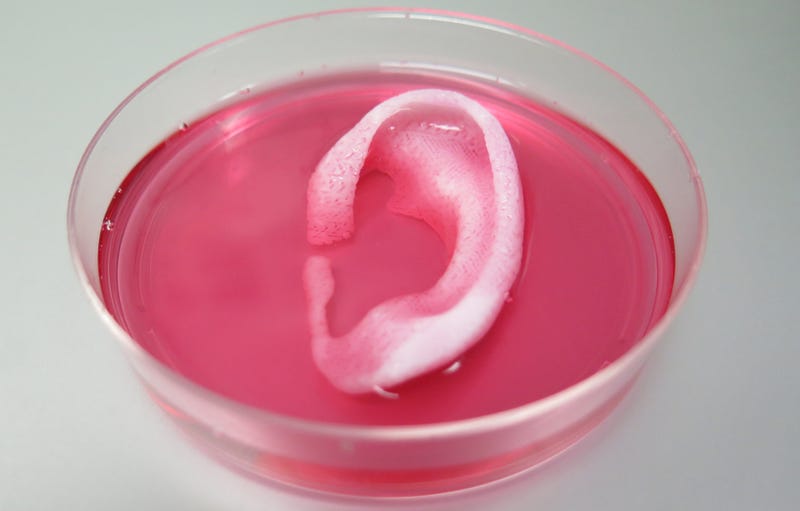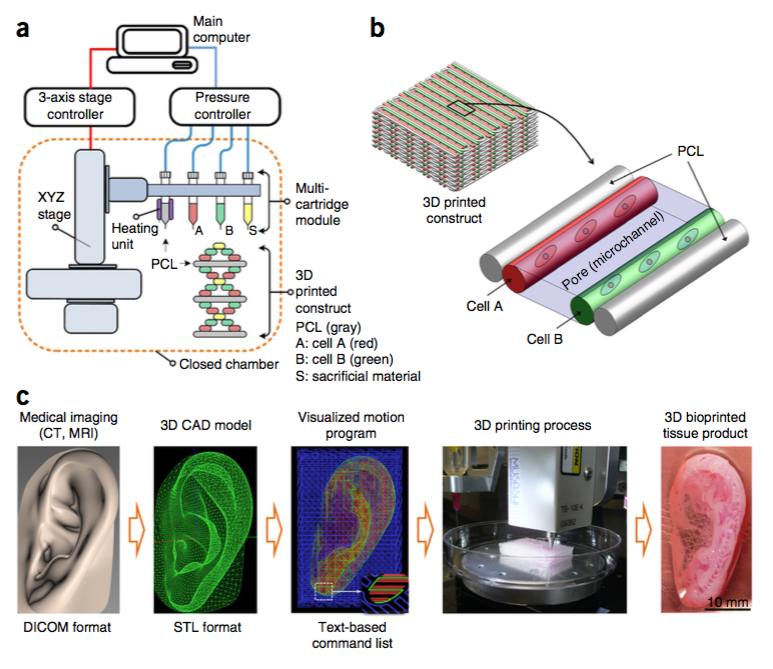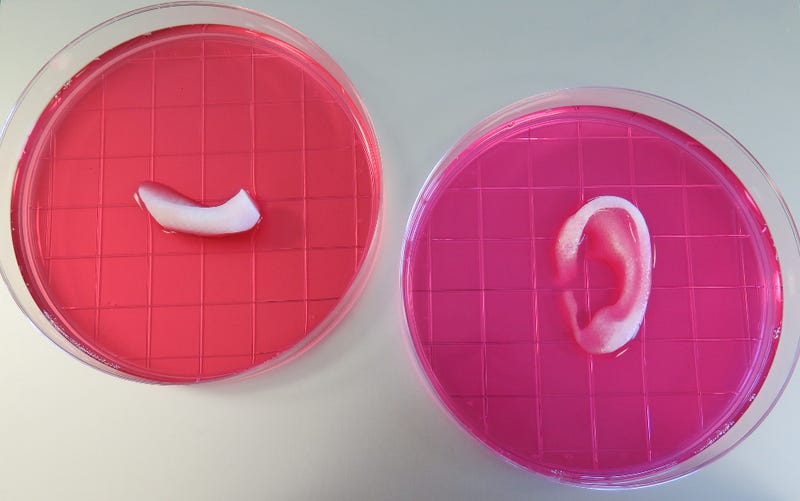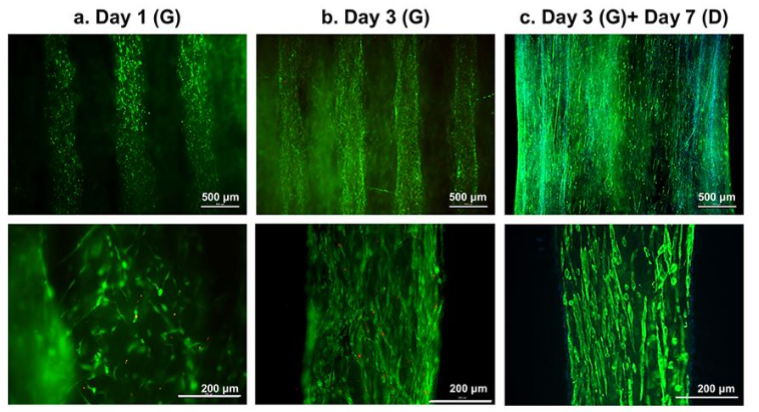Bioprinting Body Parts
Scientists Just 3D Printed a
Transplantable Human Ear

Credit: Wake Forest Institute for Regenerative Medicine
Scientists
have developed an innovative 3D bioprinter capable of generating replacement
tissue that’s strong enough to withstand transplantation. To show its power,
the scientists printed a jaw bone, muscle, and cartilage structures, as well as
a stunningly accurate human ear.

Credit:
Wake Forest Institute for Regenerative Medicine/Nature Biology
Bioprinters work the same way that conventional 3D printers do, using additive manufacturing to build complex structures layer by layer. But instead of using plastics, resins, and metals, bioprinters use special biomaterials that closely approximate functional, living tissue.
But existing bioprinters cannot fabricate tissues of the right size or strength. Their products end up being far too weak and structurally unstable for surgical transplantation. They also cannot print more delicate structures like blood vessels, or vasculature. Without these ready-made blood vessels, cells cannot be supplied with critical nutrients and oxygen.
“Cells simply cannot survive without a blood vessel supply that’s smaller than 200 microns [0.07 inches], which is extremely small,” Atala told Gizmodo. “That’s the maximum distance. And that’s not just for printing, that’s nature.” He said it’s the “limiting factor” that has made bioprinting a particularly challenging technological proposition.

Credit:
Wake Forest Institute for Regenerative Medicine
The new bioprinting system overcomes each of these shortcomings. Biodegradable plastic-like (polymer) materials are used to form the tissue shape, and a water-based gel delivers the cells to the structure (the gels aren’t toxic to the cells). A temporary outer structure helps to maintain the object’s shape during the printing process. To address the size limit, the researchers embedded microchannels into the design that allow nutrients and oxygen to be transported to cells anywhere within the structure.
“We basically recreated capillaries, creating microchannels that acted like a capillary bed,” said Atala.

Credit:
Wake Forest Institute for Regenerative Medicine
To test their 3D-printed bio-parts, the researchers performed a number of experiments on live animals. Human-sized external ears were implanted under the skin of mice. After two months, the ears still maintained their shape, and cartilage tissue and blood vessels had formed. Printed muscle tissues were implanted in rats, and like the ears, they too maintained structural integrity.
Stem cells were used to create fragments of jaw bones, which were transplanted in rats. Five months later, the structures had formed vascularized bone tissue. In the future, 3D-printed bones could be used for facial reconstructions in humans.

Vascularization
of a 3D printed ear after three months. Credit: Wake Forest Institute for
Regenerative Medicine/Nature Biology

Immunofluorescent
images show 3D printed muscle organization from one to three days. Credit: Wake
Forest Institute for Regenerative Medicine/Nature Biology
Atala said his team’s 3D-printed tissues appear to have the right size, strength, and function for use in humans. Their system can generate human-scale, structurally stable tissues in virtually any shape, and parts can be modeled in a computer according to the precise physical needs of a patient.
Once the structures are proven safe and effective, the researchers can start to think about human trials. However, “We’re still looking at the safety of these things,” Atala conceded. “It’s still going to be a while—we still have to go through a lot of testing.”
See [Nature Biotechnology]
Growing New Teeth Could Be A Possibility With These Stem Cell Dental Implants

Credit: Science Burger
Stem
cell dental implants that grow right in your mouth could replace artificial
implants.
Stem cell research has been on the rise for quite some time, as these cells are highly transformable and can repair tissue by continually dividing into either a new stem cell for further growth or a specialized cell. The specialized cell would eventually have a job, and includes red blood cells, skin cells, or muscle cells.
In the case of these new stem cell transplants, stem cells from mice were mixed with human gum cells and transplanted into adult mouse kidneys. The cells grew into “recognisable tooth structures coated in enamel with viable developing roots.” The cells taken from human gum tissue were epithelial “surface lining” cells those taken from mouse embryos were mesenchymal stem cells. The mesenchymal cells are very diverse, as they can develop into a wide range of structures such as bone, cartilage, and fat.
Professor Paul Sharpe, who led the research team at King’s College London, explained:
“Epithelial cells derived from adult human gum tissue are capable of responding to tooth-inducing signals from embryonic tooth mesenchyme in an appropriate way to contribute to tooth crown and root formation.”
The research still has some ways to go because the group has the added challenge of finding a way for adult human mesenchymal cells to react in the same ways as embryonic. Leaving embryonic stem cells out of this groundbreaking finding is what could make the dental treatment more viable for the market, since stem cells from embryo raise questions of morality. Sharpe adds:
“We’ve shown in the lab that you can use epithelial adult cells with tooth-inducing mesenchymal cells from embryos and we’ve shown that embryonic epithelial cells with mesenchymal adult cells can grow new teeth. Now we need to combine adult epithelial and adult mesenchymal cells. It’s one of the last pieces of the puzzle.”
If the research team develops a way to make the two adult human cells to work as well as adult and embryonic cells, this could make the treatment more cost effective and better for patients seeking implants. The procedure and healing time are much more efficient than artificial implants, not to mention these stem cell implants will last forever.
Do you think that people will be willing to have a tooth grow in their mouth in the place of having artificial implants surgically inserted?
From True Activist @ http://www.trueactivist.com/stem-cell-dental-implants-that-grow-in-your-mouth-to-replace-fake-implants/
For more information about 3d printing see http://nexusilluminati.blogspot.com/search/label/3d%20printing
For more information about artificial organs see http://nexusilluminati.blogspot.com/search/label/artificial%20organs
- Scroll down
through ‘Older Posts’ at the end of each section
Hope you like this
not for profit site -
It takes hours of work every day by
a genuinely incapacitated invalid to maintain, write, edit, research,
illustrate and publish this website from a tiny cabin in a remote forest
Like what you see? Please give anything
you can -
Contribute any amount and receive at
least one New Illuminati eBook!
(You can use a card
securely if you don’t use Paypal)
Please click below -
Spare Bitcoin
change?
For further enlightening
information enter a word or phrase into the random synchronistic search box @
the top left of http://nexusilluminati.blogspot.com
And see
New Illuminati – http://nexusilluminati.blogspot.com
New Illuminati on Facebook - https://www.facebook.com/the.new.illuminati
New Illuminati Youtube Channel - https://www.youtube.com/user/newilluminati/playlists
New Illuminati’s OWN Youtube Videos
-
New Illuminati on Google+ @ For
New Illuminati posts - https://plus.google.com/u/0/+RamAyana0/posts
New Illuminati on Twitter @ www.twitter.com/new_illuminati
New Illuminations –Art(icles) by
R. Ayana @ http://newilluminations.blogspot.com
The Her(m)etic Hermit - http://hermetic.blog.com
DISGRUNTLED SITE ADMINS PLEASE NOTE –
We provide
a live link to your original material on your site (and links via social
networking services) - which raises your ranking on search engines and helps
spread your info further!
This site
is published under Creative Commons (Attribution) CopyRIGHT (unless an
individual article or other item is declared otherwise by the copyright
holder). Reproduction for non-profit use is permitted & encouraged - if you
give attribution to the work & author and include all links in the original
(along with this or a similar notice).
Feel free
to make non-commercial hard (printed) or software copies or mirror sites - you
never know how long something will stay glued to the web – but remember
attribution!
If you
like what you see, please send a donation (no amount is too small or too large)
or leave a comment – and thanks for reading this far…
Live long
and prosper! Together we can create the best of all possible worlds…
From the New Illuminati – http://nexusilluminati.blogspot.com

Direct Link to fill the application form of DRDO Recruitment 2017
ReplyDeleteApply Online Punjab and Haryana High Court Clerk Recruitment 2017
driver talent crack
ReplyDeletecoolutils total pdf converter crack
iclone pro crack
avinci resolve studio crack
paragon ntfs crack
goldwave crack
pixologic zbrush crack
vsdc video editor pro crack
ummy video downloader crack
stellar data-recovery iphone crack